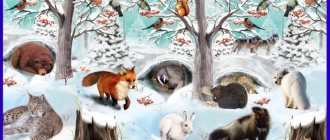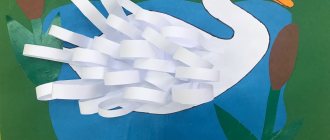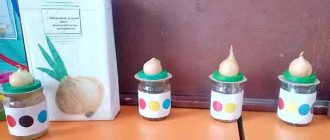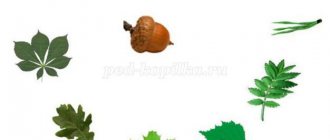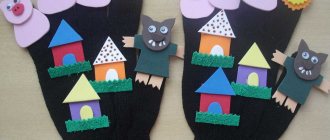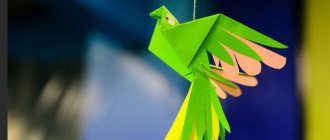Federal State Educational Standard Abstract OOD Construction “Building a fence” (junior preschool age)
OOD on design in the second junior group “Building a fence”
Goal: to develop the ability to build a simple structure as shown by an adult. Name the parts of the building material - bricks. Develop the ability to name colors correctly. Develop interest in design and attention.
Program content: To develop children’s ability to build a fence by placing bricks in a row, combining and alternating their positions by color; teach to play with buildings; show interest in the actions of a friend; develop the ability to put cubes into a box, taking into account the color.
Material: each child has bricks and toys: squirrel, dog, cat
Vocabulary work: bricks, fence, smallest side, wide side.
Methods and techniques: demonstration of a sample, showing, explanation, questions, repetition, encouragement, artistic expression, help.
Motivation: Let's help the animals.
Progress:
Educator: Children, sit on the chairs and listen to what I tell you. Animals came to visit us, but they were very upset. Do you know why? The squirrel told me that they all lived together, helped each other, and they had a beautiful fence that protected them from evil animals. But suddenly a strong wind came and broke the fence, the animals are now afraid, and they came to you asking for help. Children, let's help the squirrel and everyone else?
Children: Let's help!
Physical education minute:
Educator: Look what’s on my table.
Children: Bricks
Educator: What color are the bricks?
Children: (Answers).
Educator: Correct. From these bricks we will build a fence for the animals. Look, the bricks have the smallest side, so we’ll put the brick on it. Children, we have an uneven fence, what needs to be done?
Children: (silent).
Educator: But you need to turn them with the wide side towards me. Show Maxim where the wide side of the brick is?
Maxim: Here she is.
Educator: That's right, here is the wide side of the brick. What a beautiful fence we have made. Now let's hide our animals behind him. That's right, and I'll see which fence is the most beautiful and durable. I looked carefully, everyone turned out to have beautiful and durable fences. Well done boys. Come on, tell Sasha where your dog is.
Sasha: Behind the fence.
Educator: Correct. Dasha, show me where your cat is hiding.
Dasha: Here, behind the fence.
Educator: That's right, Dasha. Look, all the animals are happy, they liked your fences. Now we know that they are not afraid of any animals.
Abstract of the GCD for design in the second junior group: “Building Mashenka’s fence.”
Abstract of the GCD for design in the second junior group: “Building Mashenka’s fence.”
Author: Mamedova Olga Sergeevna teacher of the 2nd junior group of MADOU kindergarten No. 25
GCD theme: “Building a fence for Mashenka.”
Age group: second junior group.
Educational area: integrated (“Speech development”, “Socio-communicative development”, “Physical development”, “Cognitive development”, “Artistic and aesthetic development”).
Goal: construction of a combined fence according to the diagram (top view).
Objectives: • consolidate the skill of accurately connecting parts and lining them up in an even line (path, fence along it) during the game; • fix the names of the main parts; • introduce rhythmic alternation in the construction of bricks (on the short, narrow side) and a cube; • teach children to correlate their actions with instructions and models; • learn to use practical superimposition of details on a diagram (top view) depicting the building plan; • expand your vocabulary, learn to communicate; • teach empathy using the example of a fairy-tale character; • cultivate hard work and accuracy.
Vocabulary work: • Activation of nouns: cube, brick, prism, bar, etc. • Adjectives characterizing an object • Adjectives with opposite meanings: narrow, short, long, smooth, tall, wide, etc. • Prepositions: in, on, for, by, etc.
Equipment. Handout for the subgroup: details of a wooden building set - 6 bricks (one of them long), 5 cubes, 1 prism, small toys - nesting dolls, fence diagram (top view). Demonstration material: details of a wooden construction set, fence diagram (top view), Christmas trees, mushrooms, dolls - Masha, Bear, Cockerel; trees, a “magic bag”, a tape recorder, an audio recording of children’s songs, decoration trees for a forest clearing. Preliminary work: reading the fairy tale “Masha and the Bear”, learning a physical education lesson about a bear, learning dynamic pauses. Progress of direct educational activities Didactic game “Magic Bag”.
Goal: to consolidate the names of the main parts, the ability to find different sides of the main parts based on the description. Hello guys! Do you love fairy tales? I brought the “Magic Bag” for you. Do you want to know what lies there? I think there are toys there. Let's check?! (The teacher takes turns inviting the children to take out building parts from the bag (cube, prism, brick, block) and name them.) Show the narrow short side of the brick (swipe with your finger), the narrow long side, show the wide long side. Which side was shown? (wide and long.) Show the triangular side of the prism. Show me where the square side of the block is? Did a great job! Well, I thought that the bag was magical and there were toys in it, but there were building parts with the help of which we learn to build! But what is this? Look, there’s a picture on the long, wide side of the brick! Tell me who is shown in the picture? (The picture shows the main characters of the fairy tale “Masha and the Bear”). Yes, the bag really turned out to be “magical” and, in my opinion, invites us to go to a fairy tale! Motivation.
Goal: to motivate children to further joint activities. What is the name of the fairy tale that we recently read? A completely different story happened to the main characters of this tale. Do you want to know what else happened to Masha and the Bear? (The teacher turns on the musical accompaniment.) - Well, then let's hit the road. Hush, hush, don’t make noise, Don’t frighten off our fairy tale / raise your finger to your lips, say shhhh / One - two - spin around, Find yourself in our fairy tale! Children, as directed by the teacher, walk in a circle, raising their legs high, squat down, stand up and continue moving towards the table. Reinforcing the material covered during gaming activities.
Goal: creating conditions for generalizing and consolidating acquired knowledge, consolidating the ability to select the right part for building an object and characterize it. Look where we ended up? (there are decoration trees in the group.) We came out to a forest clearing, Raise our legs higher, Through the bushes and hummocks, Through the branches and stumps. We walked for a very long time, Our little legs were tired, Now we’ll sit down, rest, And then we’ll go for a walk again. Look, there’s something in the clearing. Let's come over! (On one side of the table there are trees, the mushrooms are a forest, on the other side there is a house built from a cube and a prism, and a Masha doll.) One day Mashenka went into the forest for mushrooms (the teacher plays out his story), mushroom after mushroom, tree after tree, so it was not noticeable and went far into the forest from the house, and got lost. “Aw! Aw!” - no one responds. Mashenka cannot find her way home. I started crying. What to do? How to help the girl? What can I do to prevent Masha from getting lost? How can I help her return home? (Build a path.) This will be a long brick. The path turned out to be level and smooth. Narrow or wide? Long or short? And on the other side of the forest, Mishka crawled out of the den (the teacher shows the toy Bear). We will show you how the Bear got out of the den. Physical education minute.
Goal: preventing fatigue, restoring children's performance, preserving health. (The teacher turns on the musical accompaniment.) The bear crawled out of the den and looked around at the threshold. He stretched out of sleep: Spring has come to us again. To quickly gain strength, the bear twisted its head. He leaned back and forth, and there he was walking through the forest. The bear is looking for roots and rotten stumps. They contain edible larvae - vitamins for the bear. Finally, the bear had eaten and sat down on a log. /Children repeat the movements after the teacher in accordance with the text and pronounce the words/. Creating a problematic situation.
Goal: to activate the mental activity of children, to encourage them to independently search for an answer to a problem situation. This is the Bear who is making his way through the forest and wants to grab Mashenka and take her to the den - his home! Mashenka ran along our path to the house, and the Bear was about to catch up with her. Masha came running and hid in the house. Let us also leave Mishka and sit down at the tables. Guys, how can I help Mashenka? What can she do to prevent the Bear from getting into her house? If the children have difficulties, the teacher asks a leading question: What will we build around the house? (Fence.) Explanation and demonstration of the construction.
Goal: familiarization with the rhythmic alternation in the construction of bricks (on the short, narrow side) and a cube. Watch how I build a fence for Masha near the path. I take a brick and put it on the narrow short side, put a cube next to it, put the parts close to each other, put the brick again on the narrow short side, then the cube, and so on. A Cockerel (a small toy) flew onto my fence and sang: “Ku-ka-re-ku!” He was surprised: “Where did such a beautiful fence come from? How was it built?" Tell Cockerel how to build this fence? Practical part.
Goal: learning to act according to a model, supporting children’s independence, strengthening the skill of accurately connecting parts and lining them up in an even line. You will build a fence using a diagram - top view (demonstration on the board). Find a long brick and place it on the table - this is a path. Place the diagram in front of the track and you will place the parts on it. Help Masha, build a fence! Cockerel and I will check how you will build fences correctly. Independent work of children. (During the work, the teacher stimulates the children’s activities and directs them to correct errors using targeted questions). What parts will we use to build a house (cube and prism)? Build a house behind the fence. Role-playing game “Guests have come to us.”
Goal: teaching the ability to play out a simple plot in a building, expanding the vocabulary of children. The bear saw the fence and returned to the forest to its den. And Mashenka came out of the house, rejoiced and thanked you for saving her from the Bear! Girlfriend cars will come to visit each of you. Guess who it is? Girlfriends live in a house, They all look alike. Scarlet silk handkerchief. The hand rests on the wooden sides. The Colorful Girls got a little flushed... (matryoshka dolls). They love to play in the yard behind the fence. Play with them! (The teacher hands out Matryoshka dolls, recites poems to the accompaniment of music and shows the elements of playing with matryoshka dolls). Blow the pipes, beat the spoons! The nesting dolls came to visit us. Wooden spoons, rosy matryoshka dolls. The girlfriends were walking along the path, There were just a few of them: Two Matryoshkas, three Matryoshkas and one Matryoshka. The mouse was met by girlfriends and hid in each other. And the one who stayed was the most frightened of all. Summary of the lesson with an element of reflection.
Goal: creating conditions for assessing children’s efforts in constructive activities; fostering diligence and accuracy when cleaning parts. I'm happy for you, the fences turned out beautiful, the details were placed exactly! Did you like your fences? Let's clap our hands! The nesting dolls also really enjoyed playing with you! Masha says goodbye to us and says to everyone: “Thank you!” Let's say goodbye to Masha! And it’s time for us to return from the fairy tale to kindergarten! One, two, three, Turn around, Look around, Find yourself in the group again! Here we are back from the fairy tale in kindergarten! What were you building? What parts were used to build the fence? What did they use to build it? Who did you help? Now you can build fences yourself in a group using a plastic construction set. But for further activities in the group, all the details of the designer must be removed. Well, now let's get down to business together, We need to remove the parts, Remove them and not break them, Tomorrow we will play again! Quietly and carefully place the parts in boxes. Goodbye, guys!
MAGAZINE Preschooler.RF
Municipal educational preschool institution "Kindergarten of a combined type "Ryabinka"" of the municipal formation Kozelsky district of the Kaluga region Artistic and creative activity (construction) in the second junior group “Multi-colored fences” Prepared and conducted by: Teacher of the highest category Cheglokova Lyubov Vladimirovna Sosensky 2014 Artistic and creative activity (construction) in the second junior group “Multi-colored fences” Purpose: To learn to distinguish and name such building parts as bricks, to construct elementary buildings by combining familiar forms of building material, introduce the dependence of the stability of parts on their location on the plane. Objectives: Learn to place bricks horizontally along a quadrangle, placing them close to each other. Reinforce knowledge of primary colors. Develop a desire to build buildings according to your own plans, combine them according to the plot and play them out. Foster a desire to take care of feathered friends. Handout: Construction set for each child; toys: birds (sparrows). Cardboard of different colors. Demonstration material: Toy cat bi-ba-bo. Preliminary work: Outdoor game: “Sly cat” Psycho-gymnastics: “Bird” Examination of various buildings made from small and large construction sets.Progress of the lesson:
Organizing time. A recording of birds (sparrows) singing sounds - Children, whose song is this? -Where do sparrows live? A sparrow appears. And here is the sparrow, look how small he is. - What color are the sparrow’s feathers and wings? — What color is a sparrow’s beak? Now listen to a story that happened to a sparrow and his friends. One day the sparrows were sitting in a clearing and chirping merrily, and from behind the bushes the cat Vaska was watching them, just wanting to drag the sparrows away. Guys, let's help our friends the sparrows, build a fence so that the rogue cat cannot interfere with them. But for this we need building material. Look, there is building material on my table. What are these details called (showing bricks, children’s answers). From these bricks we will build a strong, strong fence. The bricks need to be placed on the narrow long side, close to each other, at the very edge of the clearing, so that the cunning cat does not get to the sparrows. To make the fence beautiful, we will build it from bricks of different colors. Phys. Minute “Happy Sparrows”. Independent work of children. Children are building a fence around the clearing. A cheerful flock of sparrows appears and settles behind children’s fences in colorful meadows. The cheerful song of Vaska the cat sounds. On behalf of the cat Vaska, an analysis of children's works is carried out. And so that our cat Vaska can make friends with the sparrows, let’s all play a game together. Outdoor game: “Vaska the Cat.” Well done guys. Did you like the game? For such durable and beautiful fences, the sparrows have prepared a surprise for you. They give surprises.
| Next > |
